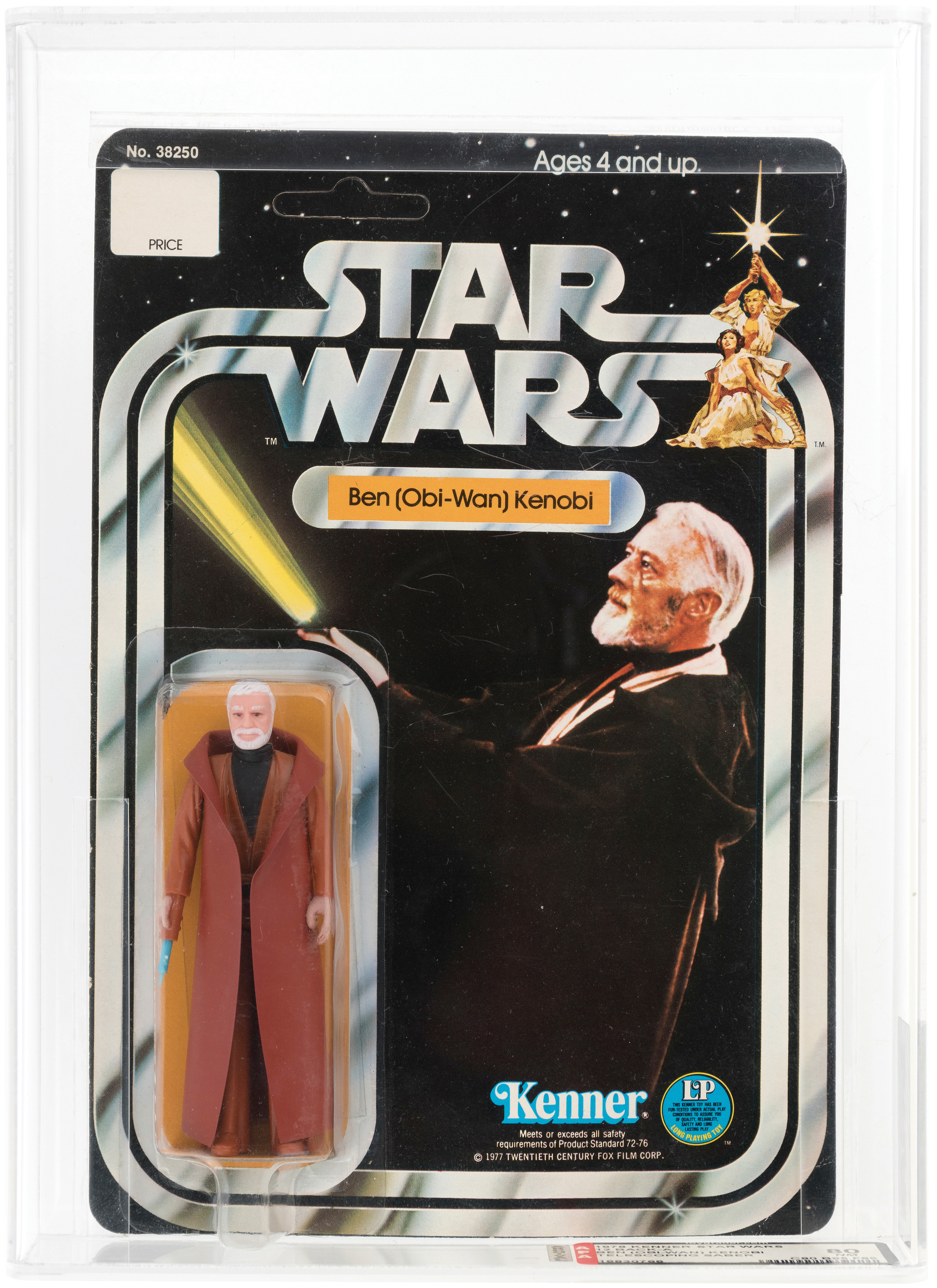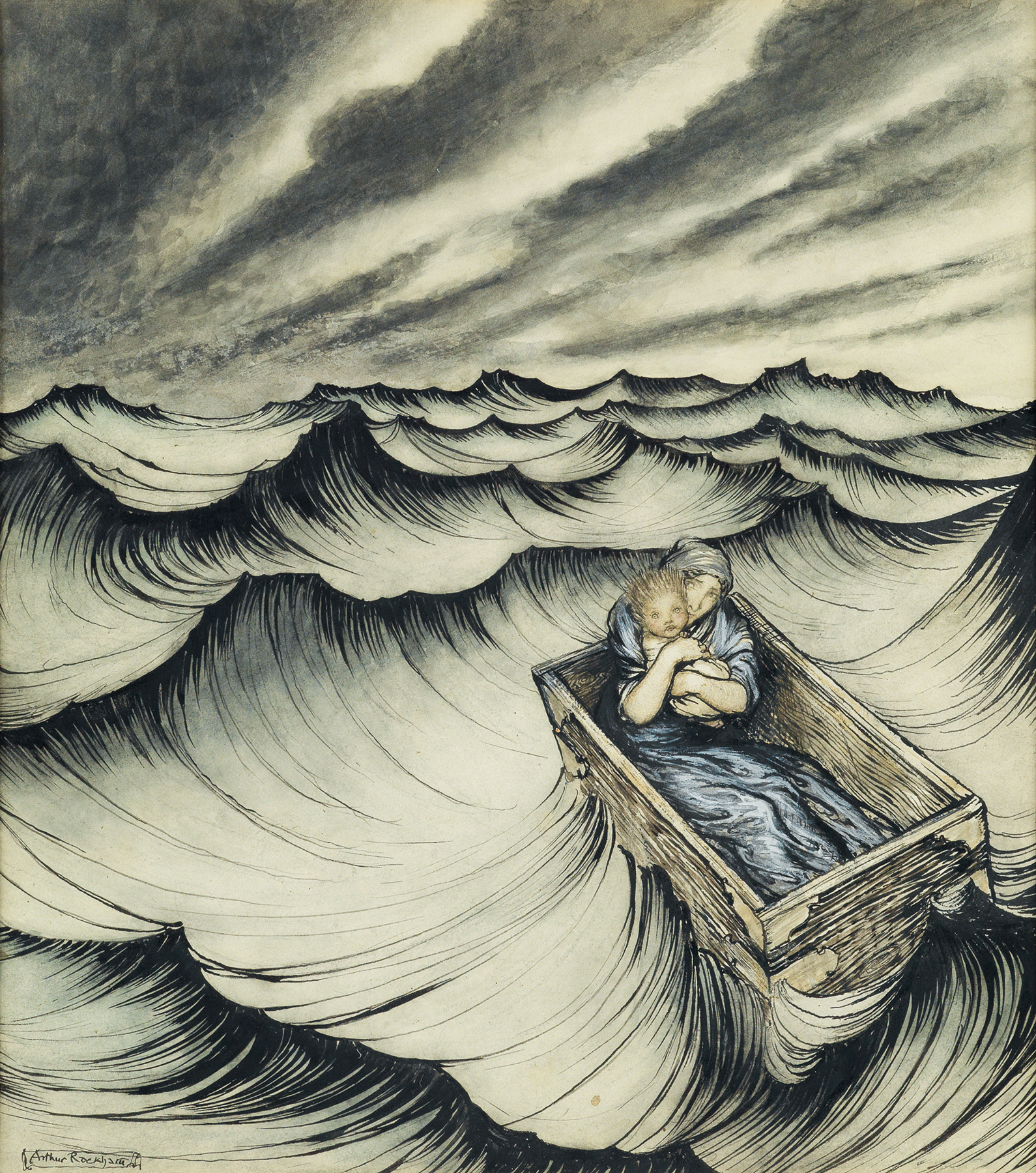RECORD! A 1978 Star Wars Obi-Wan Kenobi Sold for $76,000–an Auction Record for Any Single Production Action Figure

What you see: a 1978 Kenner Star Wars Obi-Wan Kenobi action figure with a double-telescoping lightsaber and an AFA grade of 80 NM. Hake’s Americana & Collectibles sold it in November 2017 for $76,700, setting a world auction record for any singly packaged production action figure.
The expert: Alex Winter, President of Hake’s Americana & Collectibles.
How many Ben Obi-Wan Kenobi action figures with the double-telescoping lightsaber did the Kenner toy company make? Exact production numbers are not known, but the change was made very early in the production run. This is the first of this rare version that we’ve sold. As far as I know, it is the only example sold by a major auction house in this AFA grade. We’ve had a number of other rare vintage Star Wars pieces over the years, but nothing in the same league as Ben–very little is. There are probably less than 20 known on the card [still in its unopened original packaging], and not all of those have been AFA graded and/or are in the high grade we sold. It being on its card is key. Loose figures are still in high demand and valuable, but not to the extent of carded examples–that makes it a “holy grail” item.
The lot notes say the card is ‘unpunched’. What does that mean, and why is that important? The hanger tab at the top of the card is intact. These tabs were to be punched out and the cards hung on the hooks of store displays. Any action figure that is unpunched commands a higher price.
How rare are circa 1977 unpunched Star Wars production action figures? Not crazy rare, but if you’re a high-grade collector, you want it unpunched. It adds to the value.

The lot notes say the figure has the ‘initial ‘Double-Telescoping’ lightsaber’. When and why did Kenner stop providing the double-telescoping lightsaber with its Star Wars production action figures? The first lightsaber was two pieces, with the inner piece telescoping out from the outer piece–it slides out, extending it an additional length. The production costs for this two-piece lightsaber were high, and it was thought that it didn’t add much play value for the cost. The lightsaber change was made very early in the production run to three figures: Ben, Darth Vader, and Luke Skywalker.
So there are also circa 1977 Darth Vader and Luke Skywalker action figures from Kenner with double-telescoping lightsabers? Yes. Luke is more common than the others. We’ll have a Luke in our next auction in July, and we expect it’ll get $25,000 or so.
What is AFA, and what does it mean for this toy to have an AFA grade of 80 NM? AFA [Action Figure Authority] is a professional grading company that authenticates and encapsulates all types of action figures and related toys. It’s like CGC, but for action figures. As we have seen with comic books, cards, and coins, having a third party grade items adds greatly to the value. The higher the grade, the more it impacts things. The 80 NM that the Ben had is a high grade for this figure, and it certainly added to the selling price. It also established that this was a legit double-telescoping lightsaber figure, so bidders had piece of mind about that, and again, it encouraged strong bidding.
Does AFA grade on a 1 to 100 scale? Yes, but it’s not like CGC. It’s done by fives–80, 85, 90, 95. A 95 is extremely difficult to get on an action figure because they’re graded on three components: the card, the figure, and the blister [the plastic covering the figure, which attaches to the card]. All three can have distinctly different defects. For example, you can have a beautiful figure and a beautiful blister, but a card that’s creased. It makes action figure grading a bit more difficult, but it also makes sense. We had an AFA 95 Mint Luke Skywalker in the November 2017 auction that we estimated at $10,000 to $20,000 and sold for $50,622. The person [who won the bidding] didn’t want to wait and hope to find a 95 again. The next auction will have a 95 Darth Vader.

The record-setting Obi-Wan Kenobi action figure with the double-telescoping lightsaber is from the Russell Branton Collection. Who is Branton, and how does his provenance add value? And is Branton the only person who has owned this toy? Russell Branton established himself as a serious Star Wars collector who assembled one of the best collections of vintage original trilogy Star Wars toys. It contained key pieces, rare variations, foreign issues, proof cards, prototypes, and high-grade examples. There’s no way of knowing if he was the only owner of any of the toys. They came from a variety of sources with no clear record of their history prior to his acquisition, in many cases.
What was the previous record for any singly-packaged production action figure? By how much did this Obi-Wan figure with the double-telescoping lightsaber exceed the record? I don’t have exact results, but there have been others in the $30,000 to $50,000 range at auction for single-figure carded production pieces. I’m not sure by how much, but it is established that no production action figure has ever sold for more at auction.
I understand that Hake’s has never had a physical sale room–it initially took bids by phone and mail, and now takes online bids, too. How does that change the experience of watching as a world auction record is set? We’re online three weeks before the auction closes. Most of the bidding, in general, is done in the last couple of hours, but what’s a little different about key Star Wars pieces is there’s constant action through the three-week process and heavy hitting before the close.
Did you have a notion, prior to the auction, that this Obi-Wan Kenobi action figure with the double-telescoping lightsaber could beat the record for a production action figure? We promoted this figure, and the entire collection, many months prior to the inaugural Branton offerings. Early reaction from the collecting community let us know we were most likely going to set a record. We got the collection in March 2017 and between March and November we did comics conventions and toy shows. The excitement was building, and dealers told us, ‘You’re going to be surprised.’ Originally we were going to put a $25,000 to $50,000 estimate on the Obi-Wan Kenobi action figure. In the end, we did raise the estimate to $75,000 to $100,000 based on word-of-mouth. We thought it had a chance to hit $100,000. We weren’t disappointed with $76,000, but we knew early on that it was going to set a record.
How many bidders were there initially? How long did it take for bidding on the Obi-Wan Kenobi action figure with the double-telescoping lightsaber to narrow to two people? We had eight bidders in total, including three once the figure reached the $50,000 range.
How long do you think this world auction record will stand? That’s impossible to predict, as this is still a relatively new area in the hobby, especially the graded aspect. Hake’s is really setting a precedent with the Branton sale, but who knows what is to come? Star Wars remains as popular today as when it debuted in 1977, so I don’t see any downside to Star Wars collectibles anytime soon.
What effect do you think the sale of the Branton collection will have on the Star Wars market? I think it’s going to change in a positive way. The value is going to go up. We have six, eight, ten, twelve bidders on any given piece, and four or five can be at a very high level. Star Wars has a deep, passionate field of collectors, and they have the funds to take action figures to a level not thought of a decade ago.

What else is out there that could credibly challenge the auction record set by the Obi-Wan Kenobi action figure with double-telescoping lightsaber? I think it would take the same figure in a higher AFA grade. This Ben is impressive, but it’s only an 80. If a DT [double-telescoping] shows up in an AFA 95 grade, it’d certainly bring six figures. Maybe even a 90. A 90 or higher, Ben or Darth Vader. It’s hard to say that wouldn’t get six figures based on our sale.
More Star Wars material from the collection of Russell Branton is in Hake’s Americana & Collectibles current auction, which opened online on June 19 and closes between July 10 and 12, 2018.
How to subscribe to The Hot Bid: Click the trio of dots at the upper right of this page. You can also follow The Hot Bid on Instagram and follow the author on Twitter.
Hake’s Americana & Collectibles is on Twitter and Instagram.
Image is courtesy of Hake’s.
Alex Winter last spoke to The Hot Bid about a 1939 copy of Batman’s comic book debut, which ultimately sold for almost $570,000.
Would you like to hire Sheila Gibson Stoodley for writing or editing work? Click the word “Menu” at the upper right for contact details.




